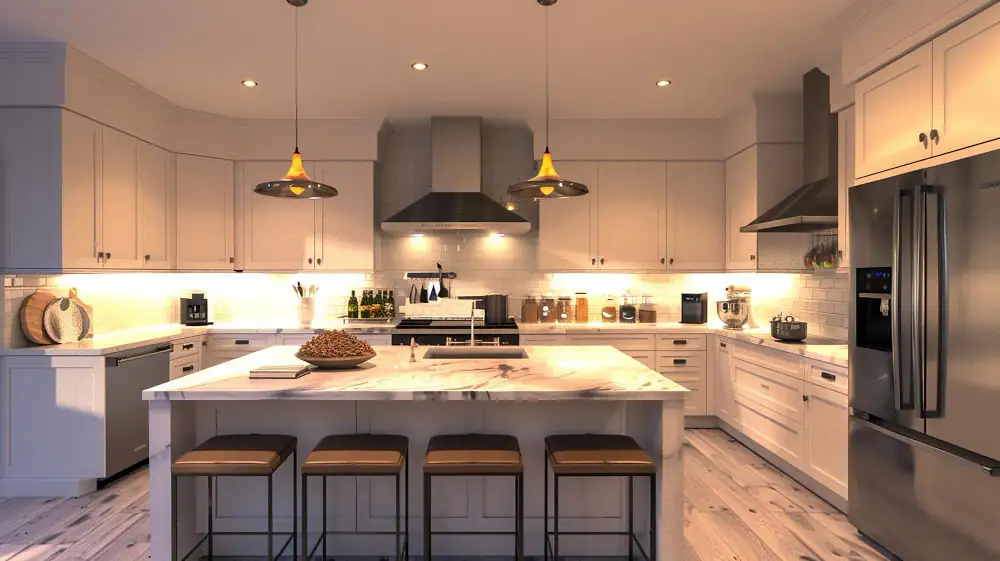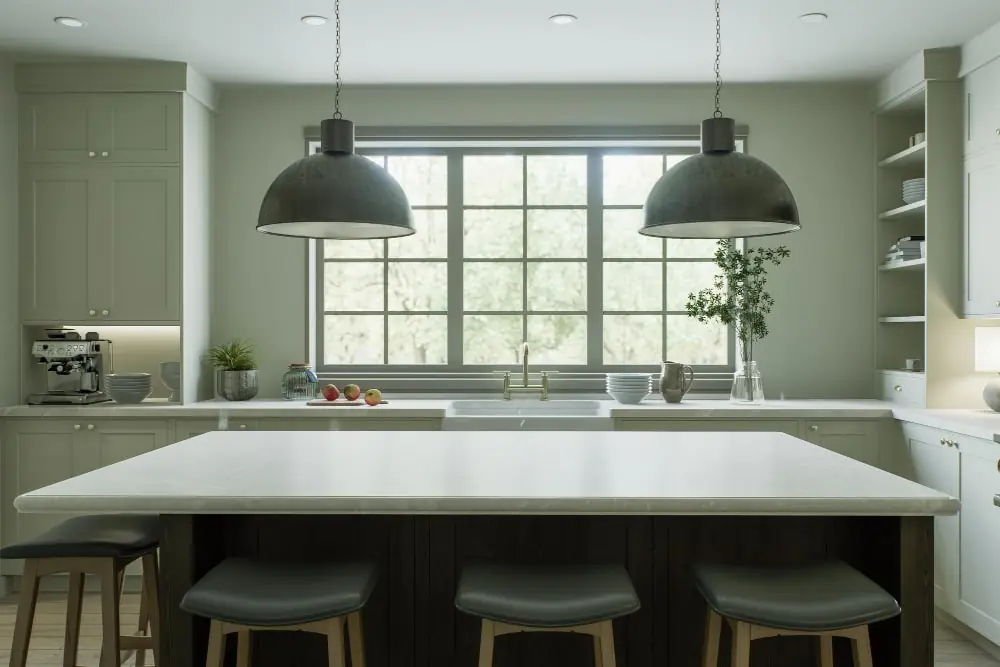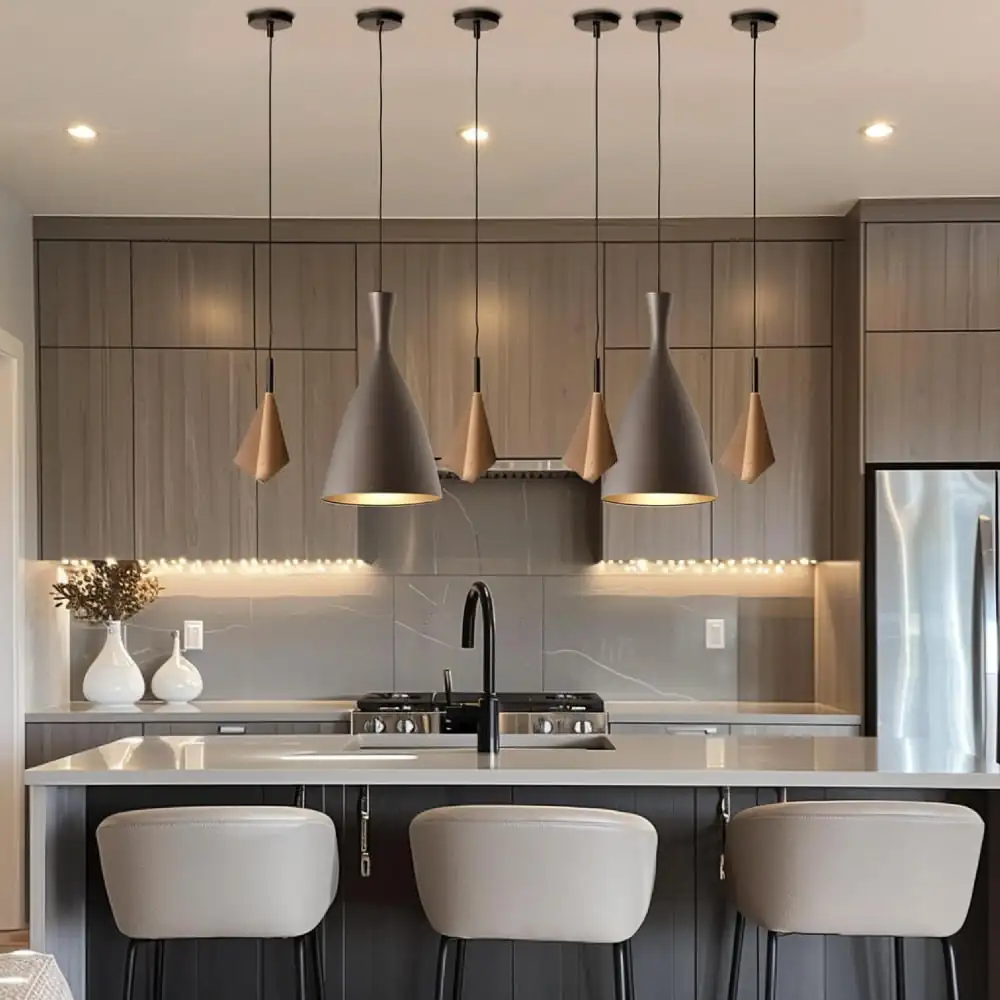When you plan your kitchen remodel, it’s essential to focus on every detail, including kitchen lighting design. Lighting plays a crucial role in your space’s functionality and ambiance. Whether you prefer pendant lights, under-cabinet lighting, or a combination of both, a well-thought-out design can transform your kitchen. Lighting sets the mood and can make the entire space look and feel more inviting and comfortable.
Before starting your kitchen renovation project, get a kitchen remodel estimate to ensure your project stays within budget while incorporating the best lighting solutions. Grand Finish Remodeling offers professional guidance to help you make informed decisions and bring your vision to life. We are here to help ensure your remodel enhances your kitchen space, turning it into a place the entire family will enjoy gathering.
Lighting plays a crucial role in your kitchen’s overall functionality and ambiance. At Grand Finish Remodeling, a well-designed kitchen lighting plan can enhance the beauty of your space while ensuring that it meets your practical needs. In this article, we will explore the art of kitchen lighting designs and learn how to incorporate task, ambient, and accent lighting to create a functional and inviting space. Let’s take a look at how important lighting can be for your kitchen remodeling upgrade!
The Importance of Layered Lighting

Layered lighting is the key to achieving a cohesive and flexible kitchen lighting design. By incorporating different types of lighting, you can create a space that adapts to your needs throughout the day, from bright task lighting for meal preparation to soft, ambient lighting for intimate gatherings.
When planning your kitchen lighting, consider the following layers:
- Task Lighting: Bright, focused light that illuminates specific work areas, such as sinks, stoves, and food prep surfaces.
- Ambient Lighting: Softer overhead lighting that provides general illumination and sets the mood for the space.
- Accent Lighting: Decorative lighting that highlights architectural features or adds visual interest to the room.
Combining these layers allows you to create a well-balanced and visually appealing kitchen lighting design that meets your functional and aesthetic needs.
Task Lighting
Task lighting is essential for ensuring your kitchen is safe and efficient. It provides bright, focused light in areas where you need it most, such as:
- Sinks: Install under-cabinet lighting or pendant fixtures above the sink to ensure that you can see clearly while washing dishes or preparing food.
- Stoves: To illuminate the cooking surface in your kitchen, choose a range hood with a built-in light or install pendant fixtures above the furnace.
- Food Prep Areas: Under-cabinet lighting or pendant fixtures above the countertops can provide proper lighting for chopping, slicing, and dicing.
When selecting task lighting fixtures, consider their placement and height. Pendant fixtures should hang between 30 and 36 inches above the illuminating surface, while under-cabinet lighting should be positioned to cast an even glow across the countertops.
For an effective task lighting setup, complement your bright spaces with durable kitchen countertops that enhance both functionality and style.
Ambient Lighting

Ambient lighting is the foundation of your kitchen lighting design, providing general illumination throughout the space. It can be achieved through a variety of fixtures, including:
- Recessed Lights: Recessed lights, also known as pot lights, are popular for ambient lighting. They should be spaced evenly throughout the room, with one light recommended for every 4 to 6 feet of ceiling space.
- Flush-Mount or Semi-Flush-Mount Fixtures: These fixtures are ideal for kitchens with lower ceilings, as they sit close to the ceiling surface. They are specially designed to provide a clean, unobtrusive look.
- Chandeliers: A chandelier can serve as ambient and accent lighting, adding a decorative touch to the room while providing general illumination. If you want a touch of classy elegance, this is a great lighting option to consider.
When positioning ambient lighting, consider your kitchen layout and aim to create an even distribution of light throughout the space. Avoid placing lights in a grid pattern, creating a harsh, institutional look. Instead, position them strategically to illuminate walkways and work areas.
Accent Lighting

Accent lighting is the final layer in your kitchen lighting design, adding visual interest and highlighting specific features of the room. It can be used to:
- Showcase Architectural Details: Install accent lighting to highlight corbels, coffered ceilings, or other architectural features in your kitchen that would be lost otherwise.
- Illuminate Displays: Use accent lighting to showcase your china collection or other decorative items in glass-door cabinets to add some classy elegance to the space.
- Create a Focal Point: To serve as the focal point of your kitchen, choose a bold light fixture, such as a large pendant light or a collection of smaller pendants.
When selecting accent lighting fixtures, consider their size and placement. They should be low-profile and unobtrusive, allowing the highlighted feature to take center stage. Ensure the fixtures are positioned to cast an even glow on the desired feature, avoiding harsh shadows or glare.
Conclusion
Achieving the perfect kitchen lighting design involves layering light to create a space that is both functional and inviting. By incorporating task, ambient, and accent lighting, you can transform your kitchen into a space that adapts to your needs throughout the day and showcases your style. When you plan your kitchen remodel, it’s essential to consider the right kitchen lighting design for both functionality and style. Good lighting enhances the overall atmosphere and highlights key areas, such as countertops and cooking spaces. A well-thought-out lighting plan can transform your kitchen into a welcoming and efficient space.
Before starting, get a kitchen remodel estimate to understand the costs involved in updating your lighting and other elements. This will help you stay on budget while achieving a beautifully lit, functional kitchen. With the right lighting, your remodeled kitchen will truly shine. If you’re ready to start planning your kitchen remodel, contact Grand Finish Remodeling for a free consultation. Our team of experts will work with you to create a customized kitchen lighting design that meets your specific needs and preferences. Skilled kitchen remodeling services are just a click away. Explore how we can help you design your dream kitchen transformation. Let’s make your vision a reality!
FAQ About Kitchen Lighting Design
Why is kitchen lighting important in a remodel?
Kitchen lighting is essential in a remodel because it significantly impacts the space's functionality and ambiance. Proper lighting enhances cooking and meal preparation visibility, sets the mood for gatherings, and highlights key areas, making the kitchen more inviting and comfortable.
What are the different types of kitchen lighting?
There are three main types of kitchen lighting: task lighting, which provides bright, focused light for work areas; ambient lighting, which offers general illumination throughout the space; and accent lighting, which highlights specific features or decorative elements in the kitchen.
How do I choose the right lighting for my kitchen?
When choosing the proper lighting for your kitchen, consider a layered approach that combines task, ambient, and accent lighting. Assess your kitchen's layout, the activities you'll perform, and the mood you want to create. Additionally, select fixtures that complement your overall kitchen design.
What is task lighting, and where should it be used?
Task lighting is bright, focused light used in specific work areas, such as over sinks, stoves, and food prep surfaces. It is essential for ensuring safety and efficiency in the kitchen. Install under-cabinet lighting or pendant fixtures above these areas to provide adequate illumination.
What are the best fixtures for ambient lighting?
Popular fixtures for ambient lighting include recessed lights, which provide even illumination, flush-mount or semi-flush-mount fixtures for lower ceilings, and chandeliers that can serve as both ambient and accent lighting. The goal is to create a soft, unobtrusive glow throughout the kitchen.
How can I incorporate accent lighting into my kitchen design?
Accent lighting can be incorporated using fixtures to highlight architectural details, illuminate decorative displays, or create a focal point with bold light fixtures like pendants. Ensure that the accent lights are strategically placed to enhance the visual appeal without causing glare.
What are some tips for creating a cohesive kitchen lighting design?
To create a cohesive kitchen lighting design, consider the overall style of your kitchen and select fixtures that complement that aesthetic. Use a combination of task, ambient, and accent lighting to ensure the space is functional and inviting. Avoid harsh grid patterns by positioning lights strategically to illuminate key areas effectively.
